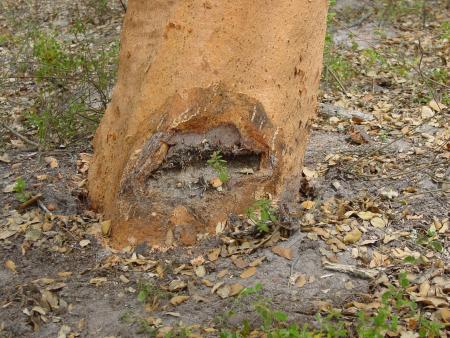
Objective:
Reducing the amount of damages in the cork oak forest is very important in terms of the sustainability of this ecosystem. Although some of the wounds may have a natural origin (e.g. lightning), most of them have a human source linked to the management operations. The cicatrisation rate of the wounds differs from tree to tree, according to wound size, the tree vitality and the time of the year (5). The establishment of simple recommendations for the forest managers to identify the potential risks associated with the operations and consequences of these wounds can contribute to increase the cork oak vitality.
Context:
In the cork oak, as in other trees, the protective function of the bark is often interrupted with the opening of wounds that expose the bark or the wood tissues.
Whenever there is a wound, the most superficial cells die, starting in the cells below (alive and intact) the recovery process. As the healing tissues consolidate, new changes develop. In reality, trees do not heal wounds, keeping them forever inside the woody tissue, but compartmentalized with new tissues in order to maintain the functional integrity of the structures.
Contacts:
Conceição Santos Silva, mcssilva@unac.pt, www.unac.pt
Further information:
- Aronson, J.; Santos Pereira, J.; Pausas, J.G. (Eds), 2009 - Cork Oak Woodlands on the Edge – Ecology, Adaptative Management, and Restoration. Island Press
- Catry, F.X.; Moreira, F.; Pausas, J.G.; Fernandes, P.M.; Rego, F.; Cardilllo, E.; Curt, T., 2012 - Cork Oak Vulnerability to Fire: The Role of Bark Harvesting, Tree Characteristics and Abiotic Factors. PLoS One.
- Costa, A., 2016 - Descortiçamento dos sobreiros ‐ Algumas noções para uma exploração racional. INIAV, I.P. 25 pp.
- Costa, A.; Pereira, H.; Oliveira, A., 2004 – The effect of cork-stripping damage on diameter growhth of Quercus suber L.. Forestry: An International Journal of Forest Research, Vol. 77, pp. 1-8.
- Hall, J.B. – Literature review of bark characteristics, wound response and harvesting. School of Agriculture and Forest Sciences, University of Wales Bangor. United Kingdom.
- Kozlowski, T.; Kramer, P.; Pallady, S. 2012 - The physiological ecology of woody plants. Academic Press.
- Moricca, S.; Linaldeddu, B.T.; Ginetti, B.; Scanu, B.; Franceschini, A.; Ragazzi, A., 2016 – Endemic and emerging pathogens threatening cork oak trees: management options for conserving a unique forest ecosystem. Plant Disease, Vol. 100, n.º 11, pp. 2184-2193